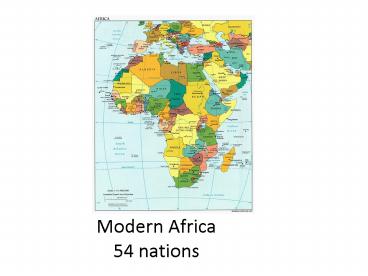Modern Africa 54 nations - PowerPoint PPT Presentation
1 / 39
Title:
Modern Africa 54 nations
Description:
To the north lies Sahara, the largest desert in the world. ... Desert The Sahara Desert, covering most of North Africa, is the largest desert in the world. ... – PowerPoint PPT presentation
Number of Views:330
Avg rating:3.0/5.0
Title: Modern Africa 54 nations
1
Modern Africa54 nations
2
- Geography of Africa
3
(No Transcript)
4
Diverse Georgraphy
5
- GEOGRAPHYAfrica
- To the north lies Sahara, the largest desert in
the world. Equatorial area is covered by tropical
rain forests. - Farther south there are areas of grassy flat
highlands giving way to coastal plains. Major
mountain ranges include Atlas in the north and
Ruwenzri on the Uganda-Zaire border. - Kilimanjaro, Africas highest mountain, is a
dormant volcano in Tanzania. To the east is the
Great Rift Valley containing several huge lakes. - Some of the worlds longest rivers drain the
continent, including the Nile, Niger, Zaire, and
Zambezi.
6
Did you know?
Africa is one of the earths seven continents. It
is the second largest continent. Africa is a land
of great beauty and resources. The earliest
evidence of human beings comes from Africa. Many
great cultures developed here.
7
(No Transcript)
8
(No Transcript)
9
(No Transcript)
10
Rift Valley, Kenya
11
The Sahara Desert
The Sahara Desert The Sahara Desert, covering
most of North Africa, is the largest desert in
the world. From north to south the Sahara is
between 800 and 1,200 miles and is at least 3,000
miles (4,800 km) from east to west. Due to the
massive size of the Sahara, Africa is split into
two regions that which lies above or forms part
of the Sahara and the rest of Africa south of the
Sahara. On the west, the Sahara is bordered by
the Atlantic Ocean and on the east by the Red
Sea, and to the north are the Atlas Mountains and
Mediterranean Sea.
12
Nations of the Sahara
13
The climate of the Sahara has undergone enormous
variation between wet and dry over the last few
hundred thousand years. During the last ice age,
the Sahara was bigger than it is today, extending
south beyond its current boundaries. The end of
the ice age brought better times to the Sahara,
from about 8000 BC to 6000 BC, perhaps due to low
pressure areas over the collapsing ice sheets to
the north. Once the ice sheets were gone, the
northern part of the Sahara dried out. However,
not long after the end of the ice sheets, the
monsoon which currently brings rain to the Sahara
came further north and counteracted the drying
trend in the southern Sahara. The monsoon in
Africa (and elsewhere) is due to heating during
the summer. Air over land becomes warmer and
rises, pulling in cool wet air from the ocean,
which causes rain. Paradoxically, the Sahara was
wetter when it received more solar insolation in
the summer. In turn, changes all in solar
insolation are caused by changes in the Earth's
orbital parameters. By around 3400 BC, the
monsoon retreated south to approximately where it
is today, leading to the desertification of the
Sahara. The Sahara is currently as dry as it was
about 13,000 years ago.
14
Dromedary camel
15
(No Transcript)
16
A Saharan village in Mali
17
(No Transcript)
18
(No Transcript)
19
(No Transcript)
20
Nairobi, Kenya
21
Lagos, Nigeria
22
Addas Ababa
23
Kinshasa, Democratic Republic of the Congo
24
Mogadishu, Somalia
25
The legendary city of Timbuktu
26
Timbuktu
27
Kampala, Uganda
28
Harare, Zimbabwe
29
African Village
30
African Village in West Africa
31
Kalahari
32
Kalahari Landscape
33
Lake Victoria
34
(No Transcript)
35
Mt Kilimanjaro Tanzania
36
(No Transcript)
37
1. A team of French and Swiss archaeologists
working in the Nile Valley have uncovered ancient
statues described as sculptural masterpieces in
northern Sudan. 2. The archaeologists from the
University of Geneva discovered a pit full of
large monuments and finely carved statues of the
Nubian kings known as the black pharaohs. 3. The
Swiss head of the archaeological expedition told
the BBC that the find was of worldwide
importance. 4. The black pharaohs, as they were
known, ruled over a mighty empire stretching
along the Nile Valley 2,500 years ago.
38
Taharqa - King of Nubia (710 - 664 B.C.) At the
age of sixteen, this great Nubian king led his
armies against the invading Assyrians in defense
of his ally, Israel. During his 25-year reign, he
controlled the largest empire in ancient Africa.
Painting by John T. Bigger
39
(No Transcript)































